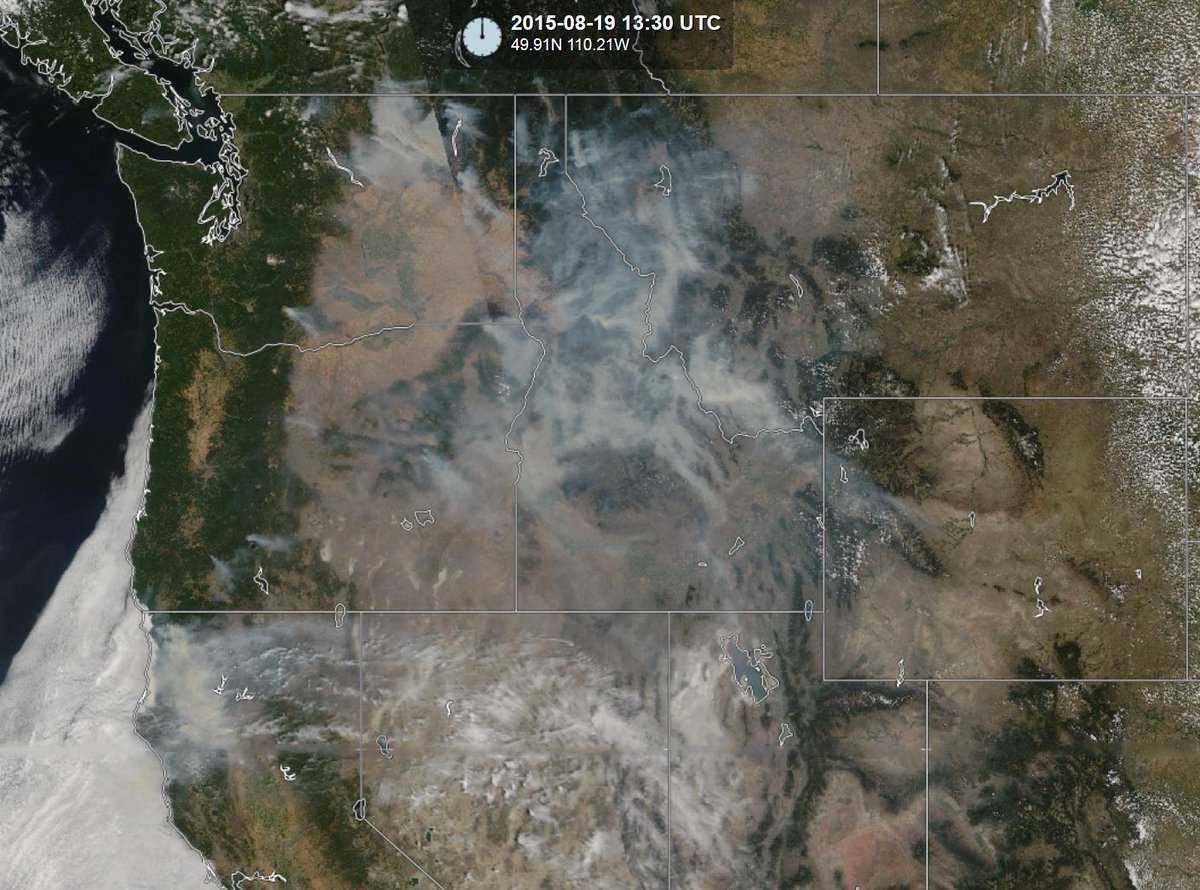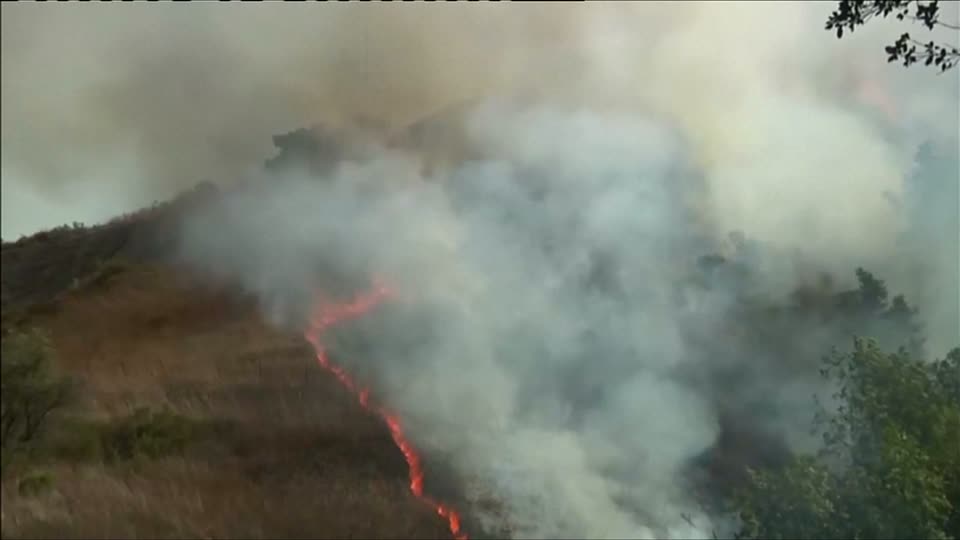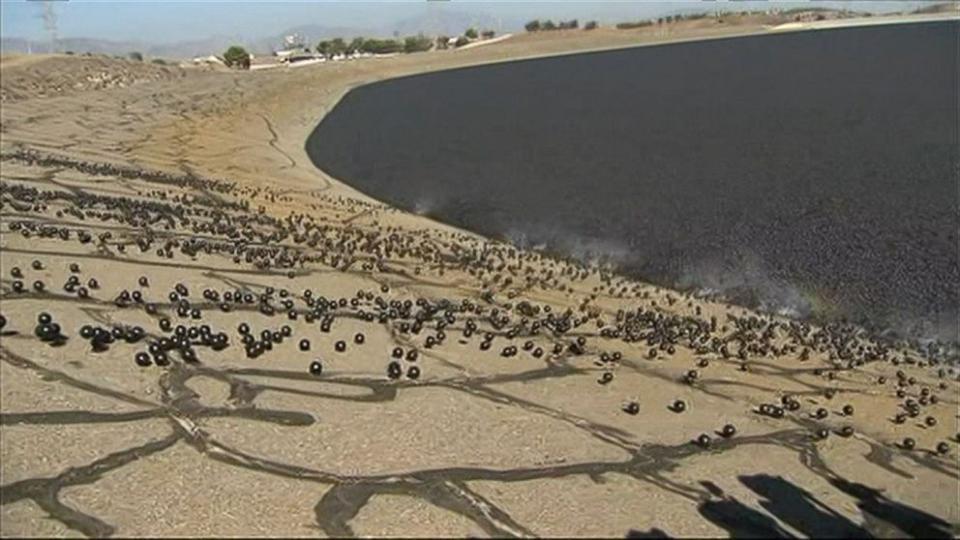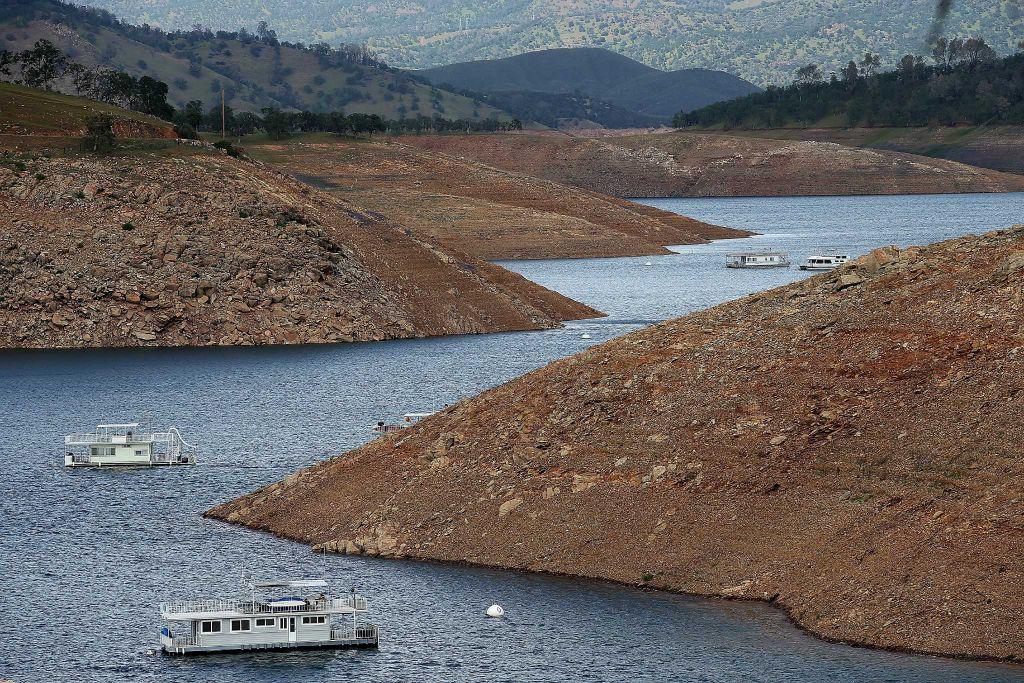Smoke from the Northern California wildfires and other major
wildfires across the Western U.S. fill the horizon as the sun sets over
Utah Lake and Provo. The U.S. Army has been asked to send 200 troops to
assist the more then 29,000 civilian firefighters deployed throughput
the West. This is the first time the Army has been called to provide
troops to fight fires since 2006: photo by George Frey/Reuters, 18 August 2015
O what can ail thee knight at arms
..Alone and palely loitering?
The sedge has withered from the Lake,
..And no birds sing!
..Alone and palely loitering?
The sedge has withered from the Lake,
..And no birds sing!
O what can ail thee knight at arms,
..So haggard and so woe begone?
The squirrel’s granary is full,
..And the harvest’s done.
..So haggard and so woe begone?
The squirrel’s granary is full,
..And the harvest’s done.
I see a lilly on thy brow
..With anguish moist and fever dew,
And on thy cheeks a fading rose
..Fast withereth too --
..With anguish moist and fever dew,
And on thy cheeks a fading rose
..Fast withereth too --
I met a Lady in the Meads,
..Full beautiful, a faery’s child,
Her hair was long, her foot was light
..And her eyes were wild --
..Full beautiful, a faery’s child,
Her hair was long, her foot was light
..And her eyes were wild --
I made a Garland for her head,
..And bracelets too, and fragrant Zone:
She look'd at me as she did love
..And made sweet moan --
..And bracelets too, and fragrant Zone:
She look'd at me as she did love
..And made sweet moan --
I set her on my pacing steed,
..And nothing else saw all day long
For sidelong would she bend and sing
..A faery’s song --
..And nothing else saw all day long
For sidelong would she bend and sing
..A faery’s song --
She found me roots of relish sweet
..And honey wild and manna dew
And sure in language strange she said
..‘I love thee true’ --
..And honey wild and manna dew
And sure in language strange she said
..‘I love thee true’ --
She took me to her Elfin grot,
..And there she wept and sigh'd full sore,
And there I shut her wild wild eyes
..With kisses four.
..And there she wept and sigh'd full sore,
And there I shut her wild wild eyes
..With kisses four.
And there she lulled me asleep,
..And there I dream'd -- Ah Woe betide!
The latest dream I ever dreamt
..On the cold hill side.
..And there I dream'd -- Ah Woe betide!
The latest dream I ever dreamt
..On the cold hill side.
I saw pale kings and Princes too
..Pale warriors, death pale were they all;
They cried ‘La belle dame sans merci
..Hath thee in thrall.’
..Pale warriors, death pale were they all;
They cried ‘La belle dame sans merci
..Hath thee in thrall.’
I saw their starv'd lips in the gloam,
..With horrid warning gaped wide
And I awoke and found me here,
..On the cold hill’s side.
..With horrid warning gaped wide
And I awoke and found me here,
..On the cold hill’s side.
And this is why I sojourn here
..Alone and palely loitering;
Though the sedge is wither'd from the Lake,
..And no birds sing ----
..Alone and palely loitering;
Though the sedge is wither'd from the Lake,
..And no birds sing ----
John Keats (1795-1821): La belle dame sans merci, 21 April 1819: text from JK journal-letter to George and Georgiana Keats, 14 Febuary-3 May 1819
An image taken by NASA's Terra satellite on 17 August 2015 shows five large fires raging through an area in the Shasta-Trinity National Forest, located west of Redding, California. To the north are two additional fires, just south of the Oregon state line. The red pixels are heat signatures detected by the Moderate Resolution Imaging Spectroradiometer (MODIS) instrument onboard NASA's Aqua satellite: image via NASA MODIS Rapid Response Team, Jeff Schmaltz, 17 August 2015 (NASA)
#MODIS continues to document extensive #wildfire smoke across the #drought stricken U.S. West #WAwx #ORwx #CAwx #IDwx: image via UW-Madison CIMSS @UWCIMSS, 19 August 2015
175 acres of the Los Angeles Reservoir covered in 96 million shade balls #drought: image via Yahoo News @Yahoo News, 13 August 2015
A bridge at the Delta-Mendota Canal, where the land sank enough for the bridge to nearly touch the water, New research by NASA scientists shows vast areas of California's Central Valley are sinking faster than previously thought as massive amounts of groundwater are pumped during the historic drought.The research released Wednesday says that in some places the ground is sinking nearly two inches a month.: photo by NASA via 89.3 KPCC, 19 August 2015
#Drought: Anyone else having a sinking feeling?: image via SF Gate @SF Gate, 19 August 2015

Fallen Sequoia, California. "The giant sequoias of California have gone through punishing storms, wildfires and environmental damages. But now, experts are worried that the prolonged drought may be the cause of the trees' death." -- Tech Times, 18 August 2015: photo by Darrell McPeake, 20 October 2011
Dead fresh water fish, known as “popocha”, float in the Cajititlan
lagoon in Jalisco State, Mexico. At least 25 tons of fish have turned up
dead in the lagoon in western Mexico and authorities are investigating
whether a wastewater treatment plant is to blame: photo by Hector Guerrero/AFP. 18 August 2015
Visitors on the bank of Folsom Lake, the lone source of water for Folsom, Calif., which plans to add 10,200 homes. Amid a drought, the lake is at 29 percent of capacity.: photo by Damon Winter/The New York Times, 19 August 2015
Folsom’s development plan calls for the construction of houses on 3,300 acres of grassland, annexed by the city, south of El Dorado Freeway. It would be economic folly, the city manager said, to shy away from growth..: photo by Damon Winter/The New York Times, 19 August 2015
The increased shoreline at the Folsom Lake State Recreation Area.: photo by Damon Winter/The New York Times, 19 August 2015
Lots opposite newly constructed homes in a housing development in Folsom. The city manager said he was confident there would be enough water for Folsom to absorb new residents.: photo by Damon Winter/The New York Times, 19 August 2015
Evening shadows of new homes fall on lots awaiting construction in Folsom, California. Amid a crippling drought, the city plans to add 10,200 homes: photo by Damon Winter/The New York Times, 19 August 2015
What California Girls should expect Valentines Day 2016 #drought: image via TAD. H @hd_shine, 20 August 2015
Smoke from the Northern California wildfires and other major
wildfires across the Western U.S. fills the horizon as the sun sets over
Utah Lake and Provo. The U.S. Army has been asked to send 200 troops to
assist the more then 29,000 civilian firefighters deployed throughput
the West. This is the first time the Army has been called to provide
troops to fight fires since 2006: photo by George Frey/Reuters, 18 August 2015








9 comments:
Terrifying and sad--the fires, the drought, and the expansion at the same time.
Nin, It's that terrible spectre, Growth. It's had the whole planet under its spell so long that this self-created tyranny no longer discloses its true face, all we get to see is the frenetic race to doom, the spread of the contagion, business as usual.
Keats, who had had medical training, had watched his mother and younger brother die of t.b., knew its course all too intimately, and was probably already aware of its symptomatic approach by this time, third week of April 1819. He asked of poetry that it be "felt on the pulse". The pulse by this time is weakening, erratic, feverish. The production mills of the market are squirreling away their nuts, yet here he is, fading, failing, distracted, falling out of the busy world's getting & spending picture --
On the cold hill’s side.
And this is why I sojourn here...
I saw those vacationers with their beach gear at dry, Growth-choked Folsom Lake as today's recreational sojourners, the consumption component in the economic cycle, sojourners, insatiable, passing through and using up but not staying long enough to check out the devastation endured by the doomed natives of the island.
...
...
before I knew somehow I knew
on the gluey shore of a brand new lake
before I knew something came true
I decided not to participate
...
...
And a very wise choice that was, Vincent.
By the by, on the Breaking News front, academic science, which is forever helpfully confirming such bold theories as "the sky is up" and "water is wet", yesterday produced a report confirming that yes, human activities are playing a role in the present catastrophic drought in California.
In a nutshell:
"A suite of climate datasets and multiple representations of atmospheric moisture demand are used to calculate many estimates of the self-calibrated Palmer Drought Severity Index, a proxy for near-surface soil moisture, across California from 1901–2014 at high spatial resolution. Based on the ensemble of calculations, California drought conditions were record-breaking in 2014, but probably not record-breaking in 2012–2014, contrary to prior findings. Regionally, the 2012–2014 drought was record-breaking in the agriculturally important southern Central Valley and highly populated coastal areas. Contributions of individual climate variables to recent drought are also examined, including the temperature component associated with anthropogenic warming. Precipitation is the primary driver of drought variability but anthropogenic warming is estimated to have accounted for 8–27% of the observed drought anomaly in 2012–2014 and 5–18% in 2014. Although natural variability dominates, anthropogenic warming has substantially increased the overall likelihood of extreme California droughts."
The article may be found here:
Contribution of anthropogenic warming to California drought during 2012–2014, from Geophysical Research Letters, 2015
Thank for the report, Tom. It's just the big picture, isn't it?
"On the gluey shore of a brand new lake"...It was a road trip in CA. I think somewhere near Mt Shasta. Hot hot. Went to some recreation area and it was that, a man-made lake. The shores were gluey mud with no plants or trees at all. It was like the hole left from a drive-by stripmining that was then filled up with water. The whole of the experience amounted to: why are people doing this, how did I get roped into this, and why is everyone else acting like nothing is wrong? They just splashed around and yahooed. So that was the little picture I recall many moons ago, 20+ years ago. End of report.
Vincent,
"The whole of the experience amounted to: why are people doing this, how did I get roped into this, and why is everyone else acting like nothing is wrong?"
This has been the whole of the experience for some time now, possibly even since the days of the California gold rush... but when you're raking in the profits, if you're American and practised in white-people ways of "thinking", it seems God meant things to be that way, California was God's gift to white Americans, so how could anything be wrong with it?
And the people in the cars streaming up and down the freeway feeder out front, they're not acting like they think something's wrong.
They're what's wrong, so of course they don't think anything's wrong.
As to reports, here's more on the recent science I alluded to above:
__
Global Warming Worsens California Drought as July Becomes Hottest Month on Record: Democracy Now!, 21 August 2015
Scientists at the National Oceanic and Atmospheric Administration released a report Thursday showing that July was Earth’s hottest month on record. Nine of the 10 hottest months since record keeping began in 1880 have occurred since 2005. Climatologists also expect 2015 to be the hottest year on record. This news comes as scientists from Columbia University’s Lamont-Doherty Earth Observatory released a report that shows that global warming has worsened the California drought, now entering its fourth year. This new study is the first to estimate the extent to which rising temperatures are affecting the loss of moisture from plants and soil, and suggests that within a few decades continually increasing temperatures and resulting moisture losses will push California into a permanent drought by 2060. We discuss the report and the impact of the findings with the study’s lead author, Park Williams, a bioclimatologist at Columbia University’s Lamont-Doherty Earth Observatory.
PARK WILLIAMS: I think we all know that as you warm the air, then the warmer air is able to more easily extract water from soils. We know this because a puddle on the sidewalk on a hot day will evaporate more quickly than a puddle on a cold day. And so, as we warm the atmosphere over a century, as we’ve done, that atmosphere is more able to pull water out of soils. And then, when natural climate variability causes a drought, as is happening right now in California, the drought is probably going to be worse.
But we’ve never actually put a number on that—how much worse, or how much of the California drought or of any drought is due to global warming. And what my colleagues and I did is put the number on that for the first time. We find that in the absence of global warming, the drought in California would have been somewhere between 8 and 27 percent less severe.
JUAN GONZÁLEZ: But how were you able to reach that conclusion?
PARK WILLIAMS: Well, we reached it using observed climate data. So we use monthly precipitation data, and then all of the—we use monthly data from all the variables that go into calculating evaporation. So that’s four variables: temperature, humidity, wind speed and solar radiation. And it turns out that in terms of the year-to-year variability and in terms of trends in evaporation, temperature is the most important of those four. And so, we then use very standard soil moisture modeling methods, where we basically treat California as this large network of buckets. And we use the climate data to, with precipitation, fill up the buckets, kind of like income fills up a bank account, and then we use the evaporation data to extract water from the bucket, like withdrawals from a bank account. And over time, we’re able to track how much water is in the buckets, and the changes represent changes in drought severity in California.
[continues:]
AMY GOODMAN: NOAA sponsored a study last year that blamed the rain deficit on what’s basically a weather-related phenomenon—what, a high-pressure ridge over the Northeast Pacific—that probably had nothing to do with global warming. Does your report contradict this?
PARK WILLIAMS: No, it doesn’t, and I’m really glad that you’re giving me an opportunity to talk about this. One of the—actually, the lead author of the NOAA study you just talked about is the second author of this study that I’ve published. And they’re two very different studies. And so, I was just talking about inputs into the water balance and withdrawals from the water balance. That study by NOAA was all about the inputs. That study found that the drought is ultimately caused by a lack of precipitation, and that lack of precipitation is ultimately caused by this really persistent, high-pressure ridge of the atmosphere that has been sitting over the Northeast Pacific Ocean and blocking storms from hitting California now for four years in a row. It’s a really abnormal event. And they find no connection with the global warming process and that ridge, or that high-pressure region.
We look at the other side of the water balance equation, the withdrawal side. And evaporation has been increasing because of warming. And so, even though climate change has not affected the precipitation—precipitation is just wildly variable in California from year to year, and so is evaporation, but underlying both of those variable things that occur naturally is this elephant in the room that’s continued to grow larger every year. And it is now—when it gets dry naturally, it is now more dry because of climate change.
JUAN GONZÁLEZ: And the economic impact on California? We’re seeing all these reports of the battles over water, obviously, exacerbated by—depending on income levels of the people experiencing it, and land sinking because of the water being drawn out from underground wells or aquifers.
PARK WILLIAMS: Well, yeah, California is seeing a lot of consequences of this drought. And all droughts have consequences. And the—presumably, it’s the kind of weakest links in the network that start showing signs of vulnerability first. And so, we have poor communities that are suffering. In some of these communities, water is no longer accessible. They relied on well water. But now the water table is too low to access water, and so water has to be shipped in some places. Land is sinking in the Southern and Central Valley, and the reason is because water has been extracted from the ground at an unsustainable pace.
AMY GOODMAN: Sinking two inches every month now in San Joaquin Valley?
PARK WILLIAMS: It’s really remarkable. And these are—from my understanding, this is part of an aquifer that was established following the last glacial period. And while it is possible to put new water into some places underground, it is no longer possible in these places where the ground has compacted, because we’ve extracted the water too quickly.
[continues:]
AMY GOODMAN: You also are a specialist on how climate change affects forests worldwide. Rolling Stone wrote about you in a piece.
PARK WILLIAMS: Yes, I am one of many who study that topic. And most of my work so far has been focused on the Southwest United States, which is still really relevant to California. What we found in that work is that wildfire is a direct—is a direct link to the climate system. I believe it’s part of the climate system. When you have drought, then as long as there’s fuels to burn—fuels being forests—then they will burn. And we’re seeing that in California now—we’re seeing it in Oregon and Washington, as well—because of intense drought. Now, again, this drought is caused by natural climate variability, and we’d be seeing a big fire here no matter what. But with this added impact of warming, the wildfire season is more active. And there is a secondary effect, that we have too many trees on the landscape right now. We’ve been fighting fires for a century, and that means some places haven’t had fire in a century, and there’s a lot of fuel now ready so that when a spark goes on the wrong day, we have wildfires that are far more energetic than they would be otherwise.
JUAN GONZÁLEZ: I wanted to ask you about the increasing involvement of faith leaders in the issue of climate change. Earlier this week, a group of Islamic scholars issued a call for a rapid end of the use of fossil fuels. And a couple of months ago, the pope released his groundbreaking encyclical on the environment. As a scientist, what’s your reaction to seeing now this increasing involvement of faith leaders, as a moral and religious issue the world coming to grips with climate change?
PARK WILLIAMS: Well, I think it’s encouraging. I think that the science of global warming is based purely in physics, not in faith or not in politics. And the science of how warming affects drought is also based purely in physics. And so, I’m really happy to see that leaders of any kind are letting people know, "Hey, this makes sense, and we should really be taking care of our planet." And physics tells us that we haven’t been.
[concludes:]
AMY GOODMAN: How do we take care of the planet? How do we reverse climate change?
PARK WILLIAMS: Well, so, this most recent work is on California, and I think California actually has a unique role in the world. When they change policy to become more efficient with their carbon use by using less gasoline, for example, then the rest of the United States is soon to follow. And when the United States makes a change, then the rest of the world is soon to follow. And so, California really has a surprisingly large ripple effect, I believe. And so, one thing we need to do globally, of course, is use fossil fuels in a sustainable way. I don’t think that that should go against anybody’s political beliefs. Just sustainable living makes sense. And digging up a nonrenewable resource and continuing to burn it 'til it's gone doesn’t.
From the drought perspective, California can do a lot more locally by using water sustainably. And there’s been a lot of, as we said, unsustainable groundwater use in California. And currently, actions are being taken to try and start regulations for groundwater extraction in California. What California tends to do, though, is, once it gets wet again, because of natural climate variability, they tend to forget that they just had a really catastrophic drought that reminded them how vulnerable they are. When it gets wet in another year or two, it’s important that California does not drop these measures that it’s beginning to make towards groundwater regulation.
JUAN GONZÁLEZ: And what are some of the other sustainable measures they could take? I mean, I’m always astounded when I—I learned a few years ago that the average golf course requires, during the hottest parts of the year, as much as 300,000-400,000 gallons of water a day.
PARK WILLIAMS: The numbers are astounding that golf courses and lawns use, although I would argue that in terms of sustainability for ground—or, I’m sorry, for water use in California or for anywhere, you really need to—the goal, I think, should be to create systems that are resilient to the worst droughts. And California, that’s very difficult to find that point, because California’s precipitation, its rainfall and snow, varies so wildly from year to year, it’s tough to remember exactly where the worst exists. But things like lawns and golf courses are actually pretty easy to—you just cut the pipe for the lawn and golf course, let it go dry, and nobody really cares. The things that are really tough, or the things that make drought effects really tough in California are things that are difficult to cut the line to. So, people in the agricultural communities, people’s livelihoods rely on agricultural, but some of our agricultural practices probably aren’t sustainable. And the fix is much more difficult.
Post a Comment